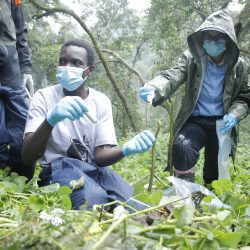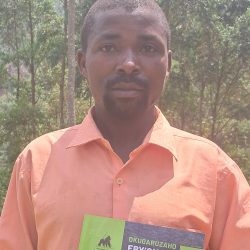Kwita Izina: Checking in on 3-year-old SACOLA
Blog | 17/06/11
Three years ago this month, a baby mountain gorilla was given a name. It wasn’t aware that it had received a name, as it was and still is a wild mountain gorilla living on the slopes of volcanoes in the appropriately-named Volcanoes National Park. This baby gorilla was given the name of SACOLA by Patrick Bergin, the CEO of the African Wildlife Foundation, on behalf of the coalition of the International Gorilla Conservation Programme as well as the people living in close proximity to the park.
Three years on, Rwanda is poised to celebrate the 7th Annual Kwita Izina gorilla naming ceremony tomorrow on June 18th, with the theme of ‘community development for sustained conservation.’ Last week, I checked in on SACOLA the gorilla thriving within the park and SACOLA the community association thriving outside of the park.
As we approached the Sabyinyo family group, through the thick bamboo in the saddle between the Sabyinyo and Visoke volcanoes, we immediately came across SACOLA and his mother Kampanga. Kampanga was lounging on her back holding her one-week-old infant, while SACOLA was playing and periodically eating nearby. Several times SACOLA came to sit near her mother and the new baby, trying to nuzzle in close to her mother, and then again going to sit several meters away.
Eventually, six-year old Isheja aka Big Ben joined SACOLA and began to groom her. And much to everyone’s delight that I was with, Guhonda the silverback of Sabyinyo group sat down between Kampanga with her infant and SACOLA and Big Ben. 40-year-old Guhonda is the largest known silverback mountain gorilla, estimated to be well over 400 pounds. He tends to sit and observe both his family and the visitors, as he did just then.
In total, there are 17 mountain gorillas in the Sabyinyo family group, and we saw a large majority of them at one time or another during our hour-long visit. SACOLA was doing well, in spite of getting caught in an antelope snare a few months previously. Thankfully, a successful intervention by the Gorilla Doctors relieved her of that potentially life-threatening burden.
It is amazing to witness the level of protection that these named mountain gorillas receive. In fact, these ‘extreme conservation’ measures have made a huge impact on improving the growth rate of these critically endangered animals. Only habituated mountain gorillas, in the groups regularly visited by researchers or tourists, are given names and offered this level of protection and care.
Being with the Sabyinyo family group was amazing and we also got some very good views of the to-be-named infant of Umurinzi who was born in August last year.
We also had quite an eye-full of the rough and tumble play of Big Ben with this infant and other young gorillas in the group. The bamboo was too thick to get a decent photograph of SACOLA. That’s one thing you have to be willing to accept when you go to see the wild mountain gorillas in Rwanda, Uganda, or the Democratic Republic of Congo. Expect to be captivated and awe-struck at being among gorillas in their own habitat. Don’t expect to get your ‘National Geographic’ photo op.
SACOLA represents what mountain gorilla tourism can mean to the development of communities around the parks in which they live. SACOLA, an association established in 2004, stands for the Sabyinyo Community Livelihoods Association representing all adult members of the Kinigi and Nyange sectors bordering the park, about 50,000 people.
This association receives income from a luxury community lodge that they are owners of, an arrangement facilitated by IGCP and AWF. This income they re-invest in conservation and development projects within their communities.
Two SACOLA villages have been built, providing adequate shelter and facilities for the community’s most vulnerable; Kinigi Cultural Center and Community Walk developed; water tanks constructed; roads rehabilitated; electricity provided to Nyange, classrooms built; the buffalo wall maintained; and more.
SACOLA, after three years of operation is moving toward having earned and re-invested 1 million USD back into the community. When speaking to someone on the ground, the return on investment in this economic activity has incredible return on investment to the communities that ultimately are responsible for the conservation of the mountain gorillas and their habitat. From preliminary assessment of ranger-based monitoring data, we’ve seen a decrease to illegal activities in the park in the areas neighboring the two SACOLA sectors. Further analysis is needed and will be reported on through this blog.
Twenty-two mountain gorillas are ready to receive names at tomorrow’s ceremony. You can take a look at them through this Flickr set, or start planning your trip to meet them in person. I am happy to report that both SACOLA the three-year-old mountain gorilla and SACOLA the seven-year-old community association both have a bright future.



